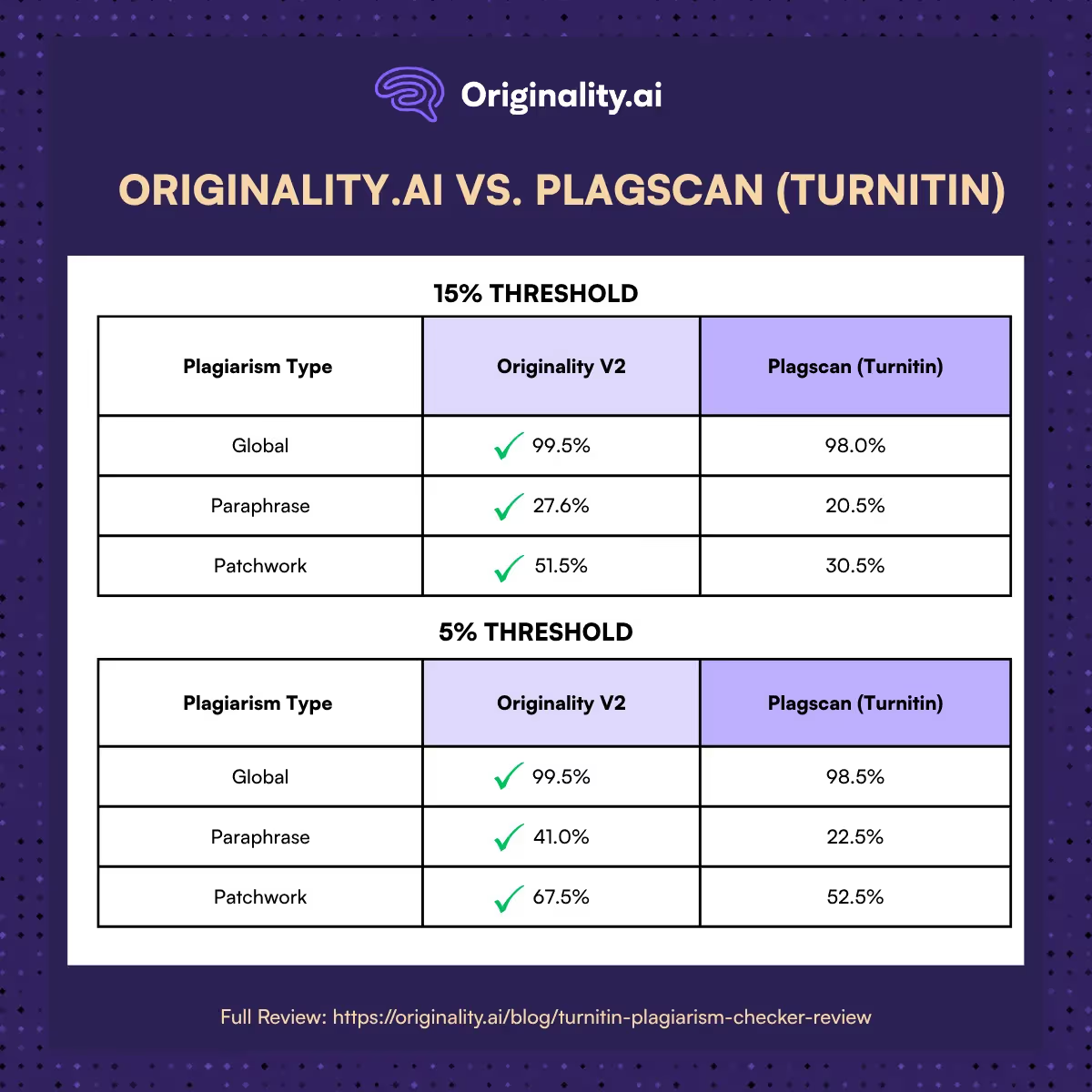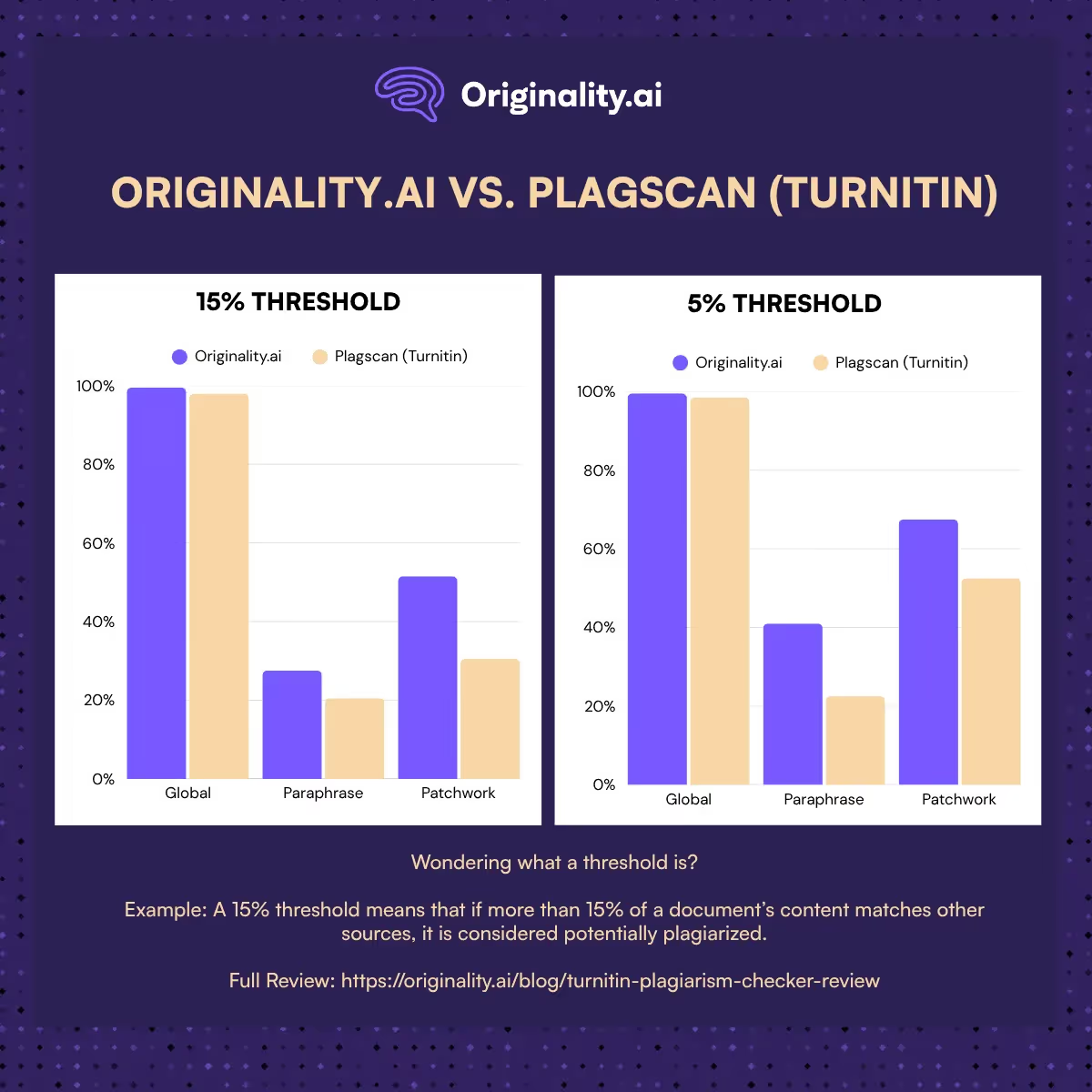When it comes to checking for academic plagiarism, Turnitin is one of the leading plagiarism checkers. It is used by schools at all levels to detect possible instances of academic plagiarism.
But how exactly does it work, and is it the best plagiarism checker for your needs?
We take a closer look here, in our in-depth Turnitin plagiarism checker review.
The Originality.ai plagiarism checker outperforms Plagscan (Turnitin) in identifying global, patchwork, and paraphrase plagiarism across 5% and 15% thresholds.
Check out the quick overview chart below at the 15% threshold:
Check out the quick overview chart below at the 5% threshold:
Note: A threshold refers to the predetermined percentage of content similarity at which a text will be flagged as plagiarized.
For example, a 15% threshold indicates that if a document has more than 15% matching content from other sources, it will be considered as potentially plagiarized.
Learn more in our Plagiarism Accuracy Study.
Turnitin is a plagiarism checker used by academic institutions to check for student plagiarism.
It works by comparing submitted documents to its large database of published works, research papers, and other student papers, looking for text similarities.
When a check is complete, Turnitin issues an Originality Check where any matching text is highlighted. It also provides a percentage that indicates the degree to which the two passages are similar.
Learn more about the types of plagiarism detection.
Turnitin’s plagiarism checker offers a number of features that make it an attractive web-based plagiarism tool, including:
Originality Check: At the core of Turnitin’s features is its Originality Check, where it compares submitted documents to others in its extensive database and reports back with a percentage where the submitted text matches another paper or document.
Similarity Reports: Similar to an Originality Check, the Similarity Report highlights similar text along with a percentage that indicates how similar it is to other content in the database.
Feedback Studio: The Feedback Studio allows educators to add comments and feedback on student papers.
Peer Review: Instructors can set up peer reviews, which allows students to give each other feedback on their papers.
Grading Tools: Instructors can include rubrics, assign grades, provide feedback, and leave custom comments with a wide range of grading tools built into the system.
Learning Management System Integration: Turnitin works with a variety of LMS (learning management systems) to allow for plagiarism checking within a familiar environment.
The first step in successfully using Turnitin Plagiarism Checker is to create an account (typically, this is available through institutional access).
You can then upload your document directly to the platform. Turnitin accepts Microsoft Word, PDF, and plain text files.
Once the file is uploaded, Turnitin then runs the originality report. It highlights any matches found across its comprehensive database. Depending on the size and the number of matches, it may take some time to complete the plagiarism check.
You should then review the originality report to determine if there are any areas where you may have inadvertently plagiarized.
You can click on each section of highlighted text to see the source, and with Plagscan you also have the option to mark the text as properly cited or quoted (if you see that sources are provided for the matching text)
If you are an instructor, you can use the Feedback Studio to add comments as well as highlight specific passages within the document. You can also optionally grade the assignment using Turnitin’s grading rubric and other tools.
There are a variety of alternatives to Turnitin Plagiarism Checker, most notably:
Grammarly – A popular grammar checker with a built-in plagiarism checker, Grammarly provides writing suggestions that help students improve the quality of their text in addition to a detailed plagiarism report.
Copyscape – An online plagiarism checker that specializes in website content, Copyscape alerts website owners if their content has been found elsewhere on the web.
Unicheck – Another academic plagiarism checker that works with a variety of LMS programs, Unicheck scans nearly 100 billion current and archived web pages to find instances of plagiarism. Unicheck has since been retired, read more.
Originality.ai – An online tool that checks for plagiarism as well as AI-written content, Originality uses artificial intelligence to detect the hallmarks of content that have been written by ChatGPT and other online writing programs (such as DeepSeek, Claude 4 Sonnet and Opus, and GPT-4.1).
Read more about AI detection accuracy, including a meta-analysis of third-party AI detection studies. Then, try the Originality.ai AI Checker.
Originality.ai is a unique plagiarism scanner and AI detector that detects AI-written and plagiarized content to determine if third-party tools were used to create content. It works for academic use (check out Originality.ai for educators) but is primarily designed for web publishers and content marketers.
Originality.ai can scan entire websites and individual content pieces and is fully scalable through a robust team management module, making it an invaluable tool for content and marketing agencies.
Plus, Originality.ai is a patented content quality solution. Learn about the Originality.ai Patent.
Turnitin is designed primarily for academia, whereas Originality.ai is designed for web professionals and agencies.
Turnitin is primarily focused on academic journals, research papers, and other student documents, whereas the Originality.ai Plagiarism Checker, is AI-powered and identifies potential instances of plagiarism by searching for matching content in Google search results.
Originality.ai allows for multiple scans that can optionally check for AI writing, plagiarism, or both.
With the ability to add and manage unlimited team members, Originality.ai is a cost-effective way to check documents at scale, and it’s an affordable way to stay confident about the quality of your content.
So, beyond its features and pros and cons, how does Turnitin stack up to some of its competitors? We put it to the test to find out.
As with any tool test that we undertake, we apply a detailed, rigorous, and fair approach.
Recently, we studied the effectiveness of popular plagiarism detection tools — including Copyscape and Grammarly as well — with Originality.ai, our unique offering in a Plagiarism Accuracy Study.
We explored key features, results, user experience, pricing, and performance in plagiarism detection.
To ensure a fair comparison, we selected a standardized set of texts with varying degrees of originality, paraphrasing, and plagiarism.
Here is a detailed comparison of the Originality.ai Plagiarism Checker compared specifically to Turnitin.
It highlights comparative plagiarism detection performance across types of plagiarism, including global, paraphrase, and patchwork plagiarism.
Check out the quick overview chart below at the 15% threshold:
Check out the quick overview chart below at the 5% threshold:

As the results demonstrate, while Plagscan (Turnitin) has long been a go-to tool for plagiarism detection, Originality.ai’s plagiarism checker has outperformed Turnitin across the board.

With advanced AI-powered algorithms, Originality.ai excels at detecting even complex and subtle forms of plagiarism, like paraphrased and patchwork plagiarism, making it more effective.
This analysis was conducted as part of our comprehensive Originality.ai Plagiarism Accuracy Study. Check out the full study to see how Originality.ai compares to Grammarly and Copyscape as well!
So, how do the other key elements of Originality.ai and Plagscan (Turnitin) compare? Here’s a quick chart to review:
Like any plagiarism checker, Turnitin has its pros and cons. Carefully consider both the benefits and drawbacks of this online tool before you decide.
High level of accuracy – Turnitin draws from numerous academic and professional databases with a high degree of accuracy. It also compares other student papers that have been uploaded to its system, helping to eliminate the chance that a student would claim someone else’s work or pay to have their essay written by someone else.
Helps students avoid plagiarism – Proper plagiarism-checking tools help students avoid plagiarism while gaining the confidence to express their ideas more ethically and adequately.
Offers a platform for private feedback – Feedback tools help students and instructors alike to improve and better understand the requirements of the assignment.
Intuitive and easy to use – The platform is incredibly user-friendly and easy to work with, even for beginners.
Works with existing learning management systems – Turnitin works with a number of popular LMS programs, making it easy to add a plagiarism checker to your existing workflow.
False positive detection – In some cases, the software may flag text as plagiarized when it isn’t, which can cost you time in reviewing each falsely flagged text to determine if it truly is plagiarism.
Expensive compared to alternatives – Turnitin has a high cost compared to other plagiarism checkers.
Paraphrase and patchwork detection is less accurate – Turnitin may not accurately flag paraphrasing or when content is reworded, leaving some areas of plagiarism undetected (see the test above for full details).
Try the industry-leading Originality.ai Plagiarism Checker today!
When instructors upload documents, according to Turnitin, they are stored within a global Turnitin repository or an institutional repository. Alternatively, there is an option not to store the submitted papers.
At Originality.ai, we believe it’s critical to protect customer content. Learn about how Originality.ai treats your content.
Turnitin notes that pricing is influenced by a number of factors, including the institution type, how many users will be accessing the tool, and what features they are opting into. As a result, they recommend contacting sales for pricing specifics.
Turnitin provides LMS integrations for platforms like Canvas, Blackboard, and D2L, including 59 partnerships.
Turnitin now highlights that it can scan content that is submitted in several languages; 176 languages in total, although it notes that the Originality Turnitin offering is available in 40 languages.
Interested in multilingual features? Learn about the Originality.ai Multilingual AI Detector.
